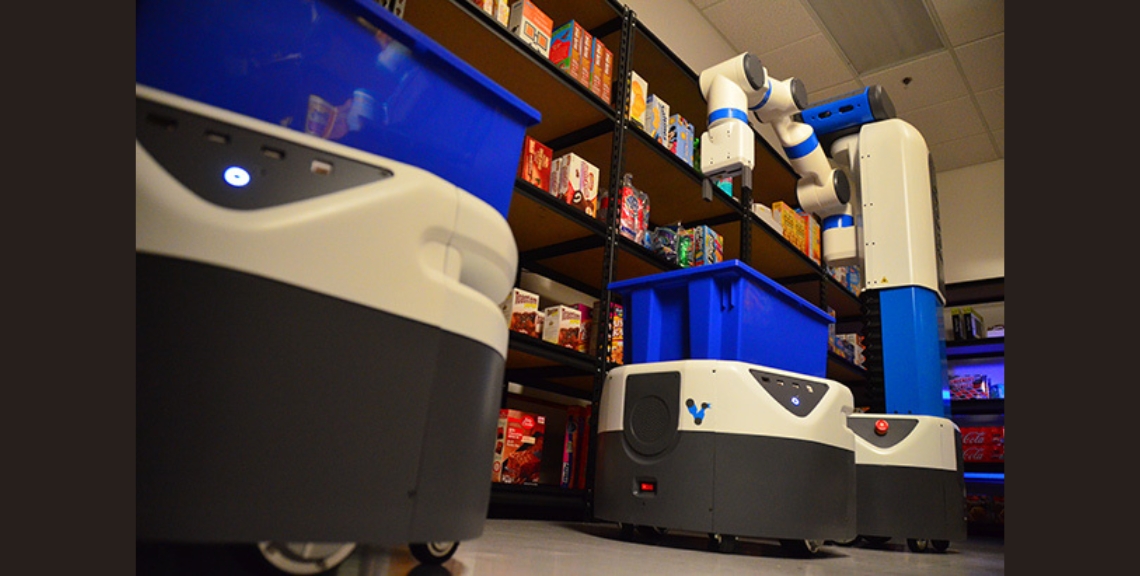The Fetch Robotics Freight Rover stands at the forefront of autonomous mobile robots (AMRs), revolutionizing material transport in diverse industrial environments such as warehouses and factories. This cutting-edge robotic system boasts an impressive capacity, capable of efficiently moving heavy payloads of up to 1,500 kilograms (3,300 pounds).
At the core of its operational prowess lies a sophisticated sensor array, featuring lidar, cameras, and sonar. These sensors work in unison to facilitate seamless navigation within dynamic surroundings, ensuring the Freight Rover adeptly maneuvers through its designated spaces while avoiding potential obstacles.
Lidar technology enables precise distance measurements, cameras provide visual perception, and sonar contributes to spatial awareness, collectively enhancing the robot’s ability to perceive and respond to its environment in real-time.
Designed for versatility, the Freight Rover excels in streamlining logistics and optimizing material handling processes. Its autonomy allows it to efficiently navigate busy warehouse floors or bustling factory settings, contributing to increased operational efficiency and reduced manual labor requirements.
In essence, the Fetch Robotics Freight Rover represents a paradigm shift in industrial automation, offering a reliable and robust solution for heavy payload transport through its amalgamation of advanced sensors and autonomous capabilities.
Timeline: Fetch Robotics’ Freight Rover Development
- 2019: Fetch Robotics announces the development of Freight Rover, a new autonomous mobile robot designed specifically for material handling and logistics tasks in warehouse environments.
- 2020: Initial prototypes of Freight Rover undergo testing in controlled warehouse settings to evaluate performance, navigation capabilities, and safety features.
- 2021: Fetch Robotics unveils the first commercial version of Freight Rover, featuring advanced sensor technology, improved navigation algorithms, and integration with warehouse management systems.
- 2022: The first deployments of Freight Rover begin in warehouses and distribution centers, demonstrating increased efficiency and productivity in material handling operations.
- 2023: Fetch Robotics continues to refine Freight Rover based on feedback from early adopters, introducing software updates and enhancements to further optimize performance and adaptability to different warehouse environments.
- 2024: Freight Rover establishes itself as a leading solution for autonomous material handling, with deployments in warehouses worldwide and ongoing research and development efforts focused on expanding its capabilities and applications.
Fetch Robotics: Pioneering Robotics Solutions Since 2013
- Fetch Robotics, the manufacturer of the Freight Rover robot, was founded in 2013, marking the inception of its innovative robotics endeavors.
- The Freight Rover robot, designed for autonomous material transportation, was introduced to the market by Fetch Robotics in 2015, showcasing its early commitment to revolutionizing logistics.
- Founded with a vision to create collaborative and autonomous robots, Fetch Robotics has since been at the forefront of developing cutting-edge solutions for warehouse automation.
- The establishment of Fetch Robotics in 2013 laid the groundwork for the subsequent development and launch of the Freight Rover robot in 2015, signifying significant milestones in the company’s evolution.
Freight Rover Robot Goal: Automating Material Handling
- Developed by Fetch Robotics to transform material handling in warehouses and manufacturing plants.
- Designed to move pallets, carts, and heavy loads autonomously, ensuring efficiency and safety.
- Boosts productivity by handling routine material movement, enabling cost reduction in labor.
- Frees up human workers from repetitive, physically demanding tasks. This allows them to focus on higher-value, more complex work.
- To achieve a streamlined, efficient, and cost-effective system for in-facility material transportation.
Market Value-Industry Wise Breakdown of Freight Rover
- E-commerce and Retail (30%):
- The e-commerce boom has increased demand for efficient warehouse and distribution center operations. Freight Rovers can be utilized for order picking, inventory replenishment, and goods transportation, enhancing productivity and reducing labor costs.
- Manufacturing (25%):
- In manufacturing facilities, Freight Rovers can streamline internal logistics processes such as material transport between production lines, inventory management, and parts delivery. This improves workflow efficiency and reduces downtime.
- Healthcare (15%):
- Hospitals and healthcare facilities often deal with the challenge of transporting medical supplies, linens, and equipment efficiently. Freight Rovers can navigate through complex environments, delivering supplies to different departments, and enhancing overall operational efficiency.
- Logistics and Warehousing (20%):
- Within large warehouses and distribution centers, Freight Rovers can automate the movement of goods, optimize storage space utilization, and facilitate inventory management. This results in faster order fulfillment and cost savings for logistics companies.
- Food and Beverage (10%):
- In food processing plants, breweries, and distribution centers, Freight Rovers can ensure timely and accurate delivery of raw materials, packaging supplies, and finished products. They comply with hygiene standards and help minimize manual handling, reducing the risk of contamination.
Freight Rover: Comprehensive Overview of its Purpose
Autonomous pallet transport robots and material handling robots have become indispensable assets in modern warehouses, revolutionizing the efficiency of logistical operations.
These advanced robotic systems are designed to seamlessly navigate warehouse spaces, transporting pallets and materials with precision and autonomy. Their ability to independently analyze and adapt to the dynamic environment ensures optimal path planning, minimizing delays and enhancing overall productivity.
Specifically tailored for warehouse applications, these robots play a pivotal role in streamlining material handling processes. Whether it’s moving pallets of inventory from one location to another or retrieving items for order fulfillment, these robots excel in enhancing the speed and accuracy of operations.
The integration of cutting-edge technologies, such as sensors and artificial intelligence, empowers these robots to make real-time decisions, avoiding obstacles and optimizing routes.
Freight Rover: Diverse Applications Across Industries
- Manufacturing: The process of transferring materials between workstations and warehouses is an integral aspect of efficient supply chain management. This crucial operation involves the physical movement of raw materials, components, or finished products within a manufacturing or distribution environment. Workstations represent specific points in the production or assembly line where tasks are performed, while warehouses serve as storage facilities for inventory.
- Smooth material flow between workstations ensures a seamless production process, minimizing downtime and optimizing overall productivity. This orchestrated movement is essential for maintaining a synchronized workflow, preventing bottlenecks, and meeting production deadlines.
- Logistics: Transporting goods from loading docks to storage areas is a pivotal step in the logistics and supply chain process. This essential task involves the movement of various products, ensuring a smooth flow from the point of arrival to designated storage zones within a facility.
- Once goods arrive at the loading docks, they undergo careful handling and organization before being transported to their respective storage areas. This phase requires the use of specialized equipment such as forklifts, conveyor belts, or automated systems, depending on the nature and volume of the goods. Precise coordination and communication are paramount to prevent bottlenecks and ensure timely deliveries.
- Efficient transportation from loading docks to storage areas contributes significantly to the overall productivity of a warehouse or distribution center. It not only enhances operational speed but also reduces the risk of damage to goods.
- Retail: Stocking shelves and moving inventory are essential tasks in the retail industry, contributing to the smooth operation of stores and ensuring a positive customer experience. Stocking shelves involves placing products in an organized manner, making them easily accessible to customers.
- Simultaneously, moving inventory encompasses the efficient transportation of goods within the store or warehouse. This task involves not only physical strength but also logistical skills to streamline the flow of products.
- By relocating items based on demand or seasonal trends, businesses can optimize their inventory management, minimizing waste and maximizing sales opportunities.
- Healthcare: Providing essential services in a healthcare setting involves the crucial tasks of delivering supplies to patient rooms and transporting medications. This multifaceted responsibility ensures the seamless functioning of medical facilities, as it directly contributes to patient care and well-being.
- The delivery of supplies to patient rooms is a fundamental aspect of healthcare logistics. This encompasses the timely and accurate distribution of medical equipment, linens, and other necessary items to individual patient spaces.
- This process is integral to maintaining a comfortable and hygienic environment for patients, facilitating their recovery while upholding stringent cleanliness standards.
In summary, the combined efforts of delivering supplies to patient rooms and transporting medications exemplify the dedication of healthcare professionals to optimize patient outcomes. These tasks underscore the commitment to providing comprehensive care and maintaining the integrity of medical services within healthcare institutions.
Target Audience of Fetch Robotics’ Freight Rover
- Logistics Providers:
- Warehouse and distribution center operators
- 3PL (Third-Party Logistics) companies
- Contract logistics providers
- Manufacturing Facilities:
- Automotive manufacturers
- Aerospace and defense manufacturers
- Electronics manufacturers
- Retail and E-commerce Companies:
- Online retailers with fulfillment centers
- Brick-and-mortar retailers with large warehouses
Benefits of Freight Rover: Cost-effective Freight Solutions
- Autonomous Efficiency: Fetch Robotics’ Freight Rover offers a revolutionary solution for material handling, boasting autonomous capabilities that enhance operational efficiency. The robotic platform seamlessly navigates through warehouses, optimizing workflow and reducing the need for manual intervention.
- Flexible Adaptability: One of the key benefits of the Freight Rover is its adaptability to various tasks and environments. With advanced sensors and a dynamic software interface, it effortlessly adapts to changing warehouse layouts and accommodates diverse materials, streamlining logistics processes.
- Increased Productivity: By automating material transportation, Fetch Robotics’ Freight Rover significantly boosts productivity. The robot operates 24/7, minimizing downtime, and enables warehouses to handle increased workloads without compromising accuracy or speed.
- Collaborative Workspace: Designed to work alongside human workers, the Freight Rover promotes a collaborative workspace. It complements human skills, taking care of repetitive and labor-intensive tasks, and allowing employees to focus on more strategic and complex responsibilities.
- Real-time Data Insights: Equipped with advanced data collection and analytics capabilities, the Freight Rover provides real-time insights into warehouse operations. This data-driven approach enables businesses to make informed decisions, optimize routes, and identify areas for further efficiency improvement.
A Technical Overview of Specifications and Functions
| Payload Capacity | 150 lbs (68 kg) |
| Weight | 218 lbs (99 kg) |
| Dimensions (L x W x H) | 47.2 in (120 cm) x 23.6 in (60 cm) x 35.4 in (90 cm) |
| Drive Train | Omni-directional with Ackermann steering |
| Speed | Up to 4.4 mph (7.1 km/h) |
| Battery Life | Up to 8 hours |
| Navigation | Lidar, depth camera, inertial measurement unit (IMU) |
| Sensors | 2x Bumpers, cliff sensors, odometry encoders |
| Communication | Wi-Fi, Ethernet |
| Extensibility | Two sets of extensibility interfaces for power, ethernet, USB, and auxiliary |
| Software | ROS (Robot Operating System) |
Environmental Factors: The autonomous mobile robot operates optimally in indoor environments characterized by dry, clean conditions with minimal obstacles. It thrives in such controlled settings, ensuring efficient and safe navigation without encountering significant hindrances.
Safety Requirements: The safety standards for the autonomous mobile robot are paramount. It must adhere to rigorous safety protocols to ensure the well-being of personnel and equipment within its operational environment. Safety features include collision avoidance mechanisms, emergency stop capabilities, and comprehensive risk assessments to mitigate potential hazards.
Regulatory Requirements: Compliance with both local and international regulations is mandatory for the autonomous mobile robot. It must meet the standards set forth by regulatory bodies governing autonomous technology, ensuring adherence to safety, operational, and ethical guidelines. Compliance with these regulations instills trust and reliability in its deployment across diverse industrial landscapes.
Usability: Designed primarily for material handling and transportation tasks, the autonomous mobile robot excels in warehouse, factory, and various industrial settings. Its versatility and adaptability make it a valuable asset for streamlining operations, enhancing productivity, and optimizing logistical processes within dynamic work environments.
Maintainability: The autonomous mobile robot boasts a self-diagnostic and modular design, facilitating ease of maintenance. With built-in diagnostic tools, it can identify and troubleshoot issues autonomously, minimizing downtime and enhancing operational efficiency. Additionally, its modular construction allows for swift component replacement and upgrades, ensuring seamless maintenance procedures.
Budget: The allocated budget for the autonomous mobile robot ranges from $32,000 to $42,000, encompassing expenses related to hardware, software, and maintenance. This budgetary framework enables the acquisition and sustained operation of the robot within predetermined financial parameters, ensuring cost-effectiveness and financial viability.
Robot Cost: The estimated cost of the autonomous mobile robot falls within the range of $40,000 to $50,000. This encompasses the initial investment required for procurement, including hardware, software, and associated components essential for its functionality and deployment in industrial settings.
Cost of Ownership: The total cost of ownership for the autonomous mobile robot spans from $20,000 to $30,000. This comprehensive estimate encompasses not only the initial acquisition cost but also ongoing expenses related to hardware and software maintenance, as well as dedicated support services. It provides a holistic perspective on the financial implications associated with owning and operating the robot over its lifecycle.
Technical Operations:
- Payload capacity: 2,500 pounds
- Battery life: Up to 16 hours on a single charge
- Speed: Up to 5 miles per hour
- Dimensions: 60 inches long x 40 inches wide x 50 inches tall
- Weight: 1,500 pounds
Success Story:
- BMW: The car manufacturer uses Freight Rovers in their logistics centers to automate the transportation of parts between different stages of the production process. This has helped to improve efficiency and reduce costs.
- DHL: The logistics giant uses Freight Rovers in their warehouses to automate the movement of goods between picking and packing stations. This has helped to improve throughput and reduce fulfillment times.
- IKEA: The furniture retailer uses Freight Rovers in their distribution centers to automate the movement of pallets of goods. This has helped to improve efficiency and reduce labor costs.
Targeted Customers of Fetch Robotics’ Freight Rover
Fetch Robotics’ Freight Rover is a versatile solution that can benefit a wide range of businesses in various industries. However, some key target customers can particularly benefit from its capabilities:
1. Warehouses and Distribution Centers:
- Challenges: Warehouses and distribution centers often face challenges such as labor shortages, inefficiencies in order fulfillment, and ensuring worker safety during manual material handling.
- Solutions: The Freight Rover can automate repetitive tasks like transporting goods, freeing up workers for more complex activities and improving overall throughput. Additionally, it can help reduce the risk of workplace injuries and potentially lower labor costs.
2. Manufacturing Facilities:
- Challenges: Manufacturing facilities often require efficient movement of materials between different production stages. Delays or inefficiencies in this process can impact production output and timelines.
- Solutions: The Freight Rover can automate the transportation of parts and materials within the facility, ensuring a smooth flow of goods and potentially improving production efficiency.
3. E-commerce and Retail Businesses:
- Challenges: E-commerce and retail businesses need to fulfill orders quickly and efficiently to meet customer expectations. Manual fulfillment processes can be slow and prone to errors.
- Solutions: The Freight Rover can automate the movement of goods within warehouses and distribution centers, expediting the picking, packing, and shipping processes. This can lead to faster fulfillment times and improved customer satisfaction.
4. Healthcare Providers:
- Challenges: Hospitals and other healthcare providers often manage large volumes of medical supplies and equipment. Manual transportation of these items can be time-consuming and inefficient.
- Solutions: The Freight Rover can automate the transportation of medical supplies and equipment within healthcare facilities, improving efficiency and freeing up staff for other tasks.
5. Logistics Companies:
- Challenges: Logistics companies strive to optimize their operations for efficiency and cost-effectiveness. Manual material handling can be a significant cost factor and can lead to delays.
- Solutions: The Freight Rover can automate various tasks within logistics operations, such as transporting goods between sorting stations or loading and unloading trucks. This can improve overall efficiency, reduce costs, and potentially expedite delivery times.
Competitive Products:
- MiR100: The MiR100 is an autonomous mobile robot (AMR) designed for material transportation in industrial settings, featuring advanced navigation and obstacle avoidance capabilities.
- MiR250: The MiR250 is a versatile autonomous mobile robot (AMR) equipped with a customizable payload capacity, ideal for automating material handling tasks in warehouses, manufacturing facilities, and logistics centers.
- Locus Robotics AMR: Locus Robotics AMR is a fleet of collaborative autonomous mobile robots designed to improve productivity in e-commerce fulfillment centers by dynamically optimizing order-picking processes.
- Boston Dynamics Hitch: Boston Dynamics Hitch is an advanced mobile robot designed for towing heavy payloads in industrial environments, featuring robust mobility and obstacle negotiation capabilities.
Company Investors, Founders & Co-Founders:
- Investors
- Founders
- Melonee Wise (CEO)
- Dave Ferguson (CTO)
- Stefan Hrabar (Robotics Lead)
- Peter Rander (Software Lead)
Website link: https://fetchrobotics.com/
Key Words: Fetch Robotics | Freight Rover | Autonomous mobile robot (AMR) | Material handling robot | Warehouse | Heavy-duty robot | Market value | Robot cost









